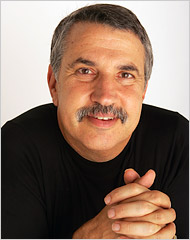Gus Van Sant on
Synecdoche, New York:
a pastiche of existence; there's no way to describe it; it's pretty intense.
Once, long, long time ago, the artist (played by
Philip Seymour Hoffman) had started to work on a gigantic project. A theater was rented in
Manhattan, shape and sizes of a huge hangar. And soon the hangar had been filled by scaffolding.
They were building a whole city inside: the real image of the outside, with streets and avenues, cars, skyscrapers, sordid apartments; and the zeppelin was flying just below the roof.
Actually the roof hadn't ever been terminated, so you were able to see the outside from inside: and here and there the two cities were looking like one and the same.
The actors were non-professionals, just bums, failures and mentally insane, as Manhattan could anytime provide enough supply. The artist had given them a total freedom how to interpret their roles. It would have been impossible otherwise: there were too many.
It should have been a performance about his life: he was trying to understand himself.
It had been the typical life of an artist destroyed by Manhattan, spiritually and physically (as any other artist living there), navigating endlessly among grandiose projects and impossible women.
He had failed with all women in his life. The first wife had left him long time ago; she had taken their four years daughter with her and had moved to Germany. Years had passed; the girl had been meanwhile initiated by a lesbian artist, who had painted her nude at different ages.
That was the story with the first wife. The second had divorced as she could bear no more the intensity of the performance. As for the third woman, he had given up that time. She would come back late in his life when both of them were far too old.
The project would never be finished, because his life was going on, with new erotic failures and endless failed projects.
And the performance arrived at the point in his life where the project had started: a new hangar appeared inside the first hangar, and a new inside city. As for the non-professional performers, with their total freedom to decide, they hired in turn other non-professionals to play them.
Which was the real city? What women were the real ones? Those who had been in his life? Those who were playing them? Those who were playing the roles of those who were playing the roles?
As for him: which of them was the real one? He, the artist? Or the bald toothless old guy with a cynical smile who was walking with a cane and was playing him? Or the other old insane, who was hired by the first one?
Was he the real one? Everybody was getting older there, it was not clear anymore whether in life or on the scene. And they were hiring bums and failures who were older and older. All his performers were decaying biologically, more and more. And they were dying eventually, and they were buried there, on the scene.
He was keeping in having accidents, each one leaving him with one more small visible infirmity. Otherwise he did not seem to look older.
Actually he was getting older and older, of course, besides cane, besides glasses. He would realize it, in the long run. Only in the long run.
Who was the real one? Was it the old bald toothless performer with cynical smile? Or
Philip Seymour Hofman?
Because it's his movie. He,
Philip Seymour Hoffman, he is playing with a tragic pathos that you cannot see often.
And you leave the theater in the end with many details that remained obscure, but who cares? You are overwhelmed, and you realize that it is your own life there, grandiose and useless; you are there in the movie, you are trying to understand yourself, but you cannot. Because you are too hypochondriac, too paranoid, too scared of your own degradation and death.
(Filmofilia)Labels: Philip Seymour Hoffman, Synecdoche















